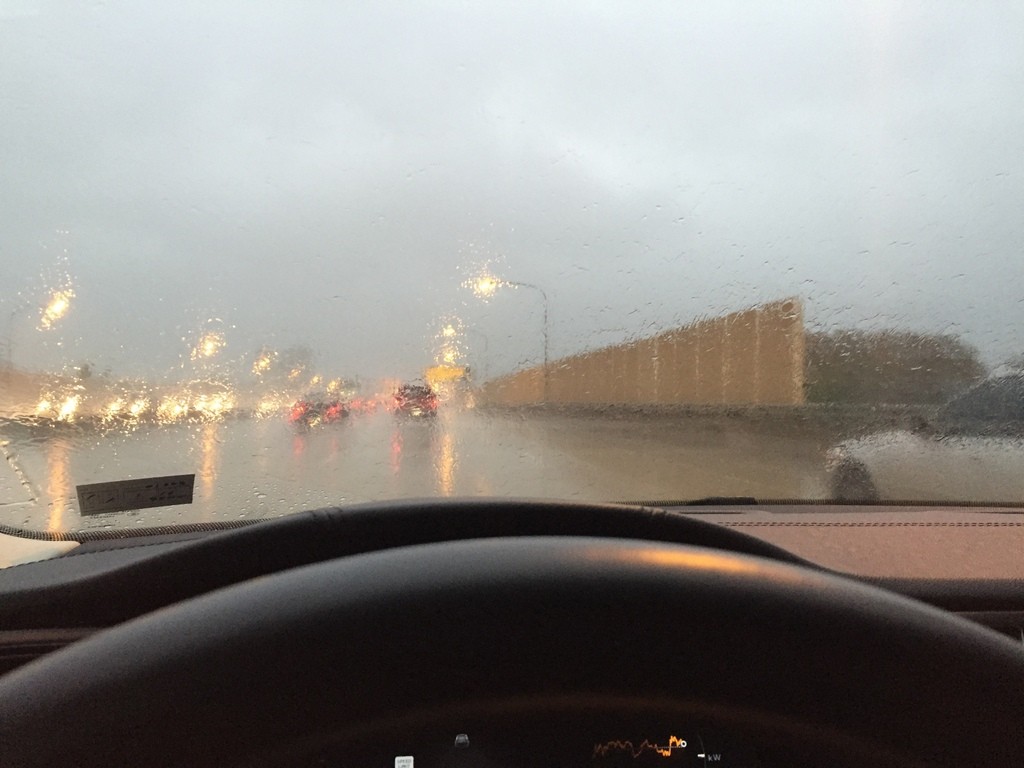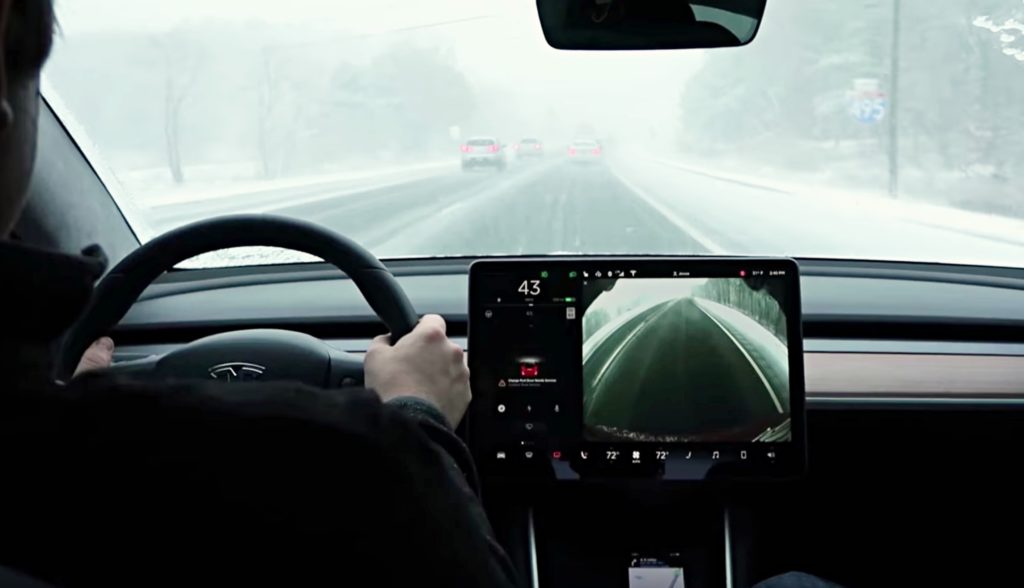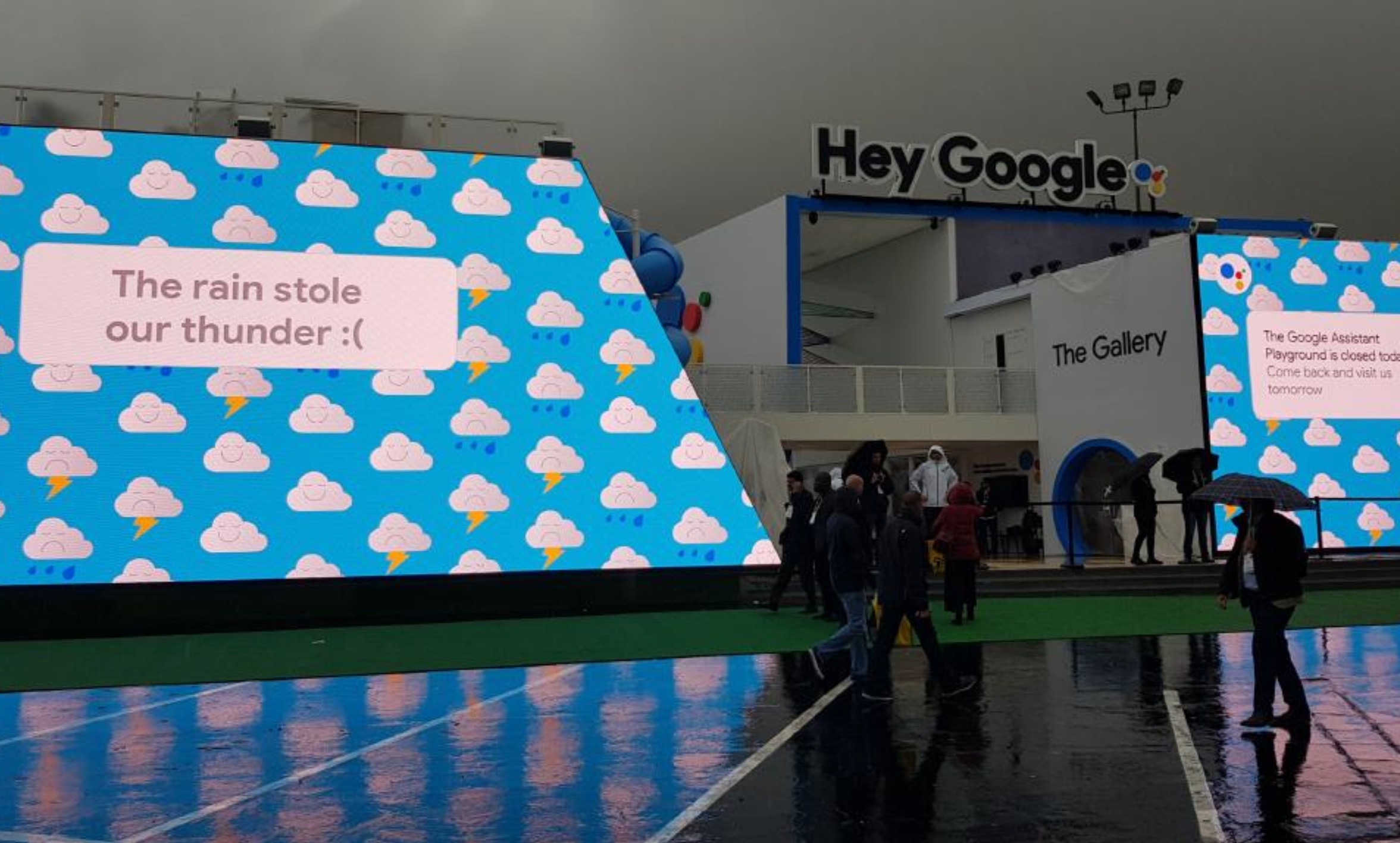

Lifestyle
Heavy rains at CES 2018 highlights self-driving technology limitations
At the Consumer Electronics Show annual showcase of technology in Las Vegas this year, something important was inadvertently highlighted. Inclement weather at CES 2018 caused several manufacturers and suppliers to cancel or significantly alter their autonomous vehicle showcases. Nissan, for example, discontinued showings of its new ProPilot technology in the 2019 Nissan LEAF electric car (demos of the LEAF otherwise continued). Other manufacturers embraced the chance to show some of their latest capabilities.
Decisions to cancel seemed based more on liability, both physical (“What if something goes wrong?”) and intangible (“If it doesn’t work, we lose face.”), than on likely limitations of the manufacturer’s technologies. Those pressing forward or even using the weather as a way to showcase capabilities were mostly smaller, less branded companies whose reputations to the public would suffer only short-term losses were things to go awry.
It literally hasn't rained in 118 days in Las Vegas. Until today. Guess we can't use this road 👀 pic.twitter.com/5sjVKDEx00
— Marques Brownlee (@MKBHD) January 10, 2018
Semi-Autonomous Systems in General
To understand why bad weather can be such a detriment to current-use and near-future autonomous vehicles we must first understand how these systems work. Most semi-autonomous systems on the road are based on a combination of three technologies, all coupled to semi-intelligent computers. These techs are radar, LiDAR, and cameras. Radar uses radio waves, LiDAR uses lasers to find ranges, and cameras use varied spectrums of light to create images for a computer to decode.
Tesla’s Autopilot uses radar and cameras to get a view of the world around the vehicle. Subaru’s EyeSight system uses cameras only, seeing ahead of the car in three dimensions, but thus far not seeing in 360-degrees. Ford’s current systems use combinations of radar, light-detection and ranging (LiDar), and cameras to see the world around the vehicle. Nissan uses radar and LiDar in the same way. General Motors, BMW, and others all use variations on these themes for their own production-level semi-autonomous systems.
The majority of these manufacturers are also either utilizing or working on utilizing GPS and mapping to augment what the vehicle’s computer systems know about the world around it. Tesla’s Autopilot uses GPS, at least in North America, to sense where the vehicle is. Including (whenever possible) which lane of the road it occupies and when the road will change (to see curves and terrain). Using GPS and mapping is much easier in North America than it is in Europe and China, where its use is more restricted.
When Weather Turns Bad
Yet with all of these technologies, there are still limitations.LiDAR does not work when the sensors are in any way blocked, such as with rain droplets or ice. Radar is often distorted by ice as well. Cameras cannot function if a clear enough image cannot be received for analysis by the computers. Thus it’s possible for all three sensing technologies to become useless when the weather is sub-optimal.
For those living in South Florida and San Diego, these are probably not anything to worry about. For the rest of the planet, though, they are a concern for a good portion of the year. Where I live in Wyoming, for example, inclement weather affects driving for about half of the year. In some parts of the world, such as Iceland, Norway, Russia, and much of Canada, the weather is sub-optimal for half the year or more. The same can be said when turning southward to the other hemisphere, especially in South America.
When visibility is low, humans compensate by making best guesses about what’s around them. We can use other cues to find our vehicle’s lane in traffic during heavy snow, for example, by relying on curbs, the tracks of cars that have gone ahead, and known landmarks. Just as we use non-visual cues such as input from the pedals and the steering wheel to know how slippery the roadway is so we can adjust speed and reactions accordingly. We do most of this subconsciously.
Computers, however, are not always that capable. They’re getting there, though. Ford has been busy creating high-resolution maps of the roadways around the world, with details such as the exact position of curbs and lane lines, where trees and signs are located, and what traffic rules are in place (speed limits and the like). The idea being that the better the knowledge the vehicle’s computers have of a given area, the more capable that vehicle will be of navigating that area without a driver’s input.
Ford says that it’s latest-generation autonomous vehicle technologies can now drive with full, unplowed snow cover blocking all lane markings and most road signs. That is confined to Ford’s Mcity, a fake town the company built to test autonomous driving. After all, Ford is a huge company and has a lot to lose should there be a fault with its systems when used out in public.
Tesla, for their part, has largely used Telsa owners as their primary test bed. So far, that’s worked for them, but it carries a very large liability should something go wrong. Most automakers are not willing to take that kind of risk and are instead developing carefully and in-house.
How Semi-Autonomous Is Doing Now
As an automotive journalist, I drive a lot of vehicles. I had more than 80 of them as test vehicles for a week or more in 2017 and more than that in 2016. This year, I will likely see at least that many or more. Plus “butt in seat,” track, and off-road events and shows where more short-term driving takes place. My experience includes vehicles with no autonomous or “driver-assist” technologies at all (e.g. Alfa Romeo 4C) and vehicles with full-on level 3 and even 4 technologies (e.g. BMW plug-ins, 2017 Tesla S). The field of currently-offered technologies for semi-autonomous driving is wide, indeed, but none of these systems are truly autonomous and most are fairly limited in use. They’re improving, but it’s gonna be a while.
With an autonomous vehicle, as Carlos Ghosn (former Nissan CEO, now CEO of Renault and Mitsubishi) said a couple of years ago during a meet the press event in Detroit, “a two-ton vehicle is a little different than a smartphone.” There’s a little more at stake with a car, in terms of safety concerns, than there is with a phone.
My personal experience has been that camera-based systems are the best when conditions are good. Subaru’s EyeSight may be the most reliable and useful of the forward-looking driver-assistance systems on the market right now. But when heavy rains or worse come, it’s all but useless. Enter Nissan’s current technologies, as found on the Murano and in much of the Infiniti line. This system adds radar and can “look under” traffic to see several vehicles ahead. Much better, but still unable to find a lane in bad weather when markings are unclear. Ford, as far as in-production technology, fares about the same, but with a somewhat less over-reactive adaptive cruise control. BMW has similar limits but has some of the best self-parking I’ve witnessed so far. Tesla has one of the best systems, especially in the current-generation with its defrosting cameras and the like. The best all-around mixture of capability, though, is what’s found in the latest Volvo vehicles. Likely due to the kind of redundancy that Volvo is so well known for when it comes to safety equipment.
With this, Tesla should be noted for their proactive nature when it comes to pushing new technologies like Autopilot and its myriad upgrades since inception. How Autopilot reacted to heavy snow in Iceland two years ago compared to how it fares almost two years later is indicative of that. The same car cannot necessarily navigate that same road under those same conditions, but it will likely hold on longer than it did and would likely be able to pull over to safety should the driver not take action on his own.
In short, we have some time before autonomous vehicles are both a reality and capable of handling the many varied conditions that humans have adapted our driving to. But with the current pace of development, vehicles capable of moving through nearly any kind of weather will be available within the next decade.

Lifestyle
Tesla Model S Plaid battles China’s 1500 hp monster Nurburgring monster, with surprising results
There is just something about Tesla’s tuning and refinement that makes raw specs seem not as game-changing.
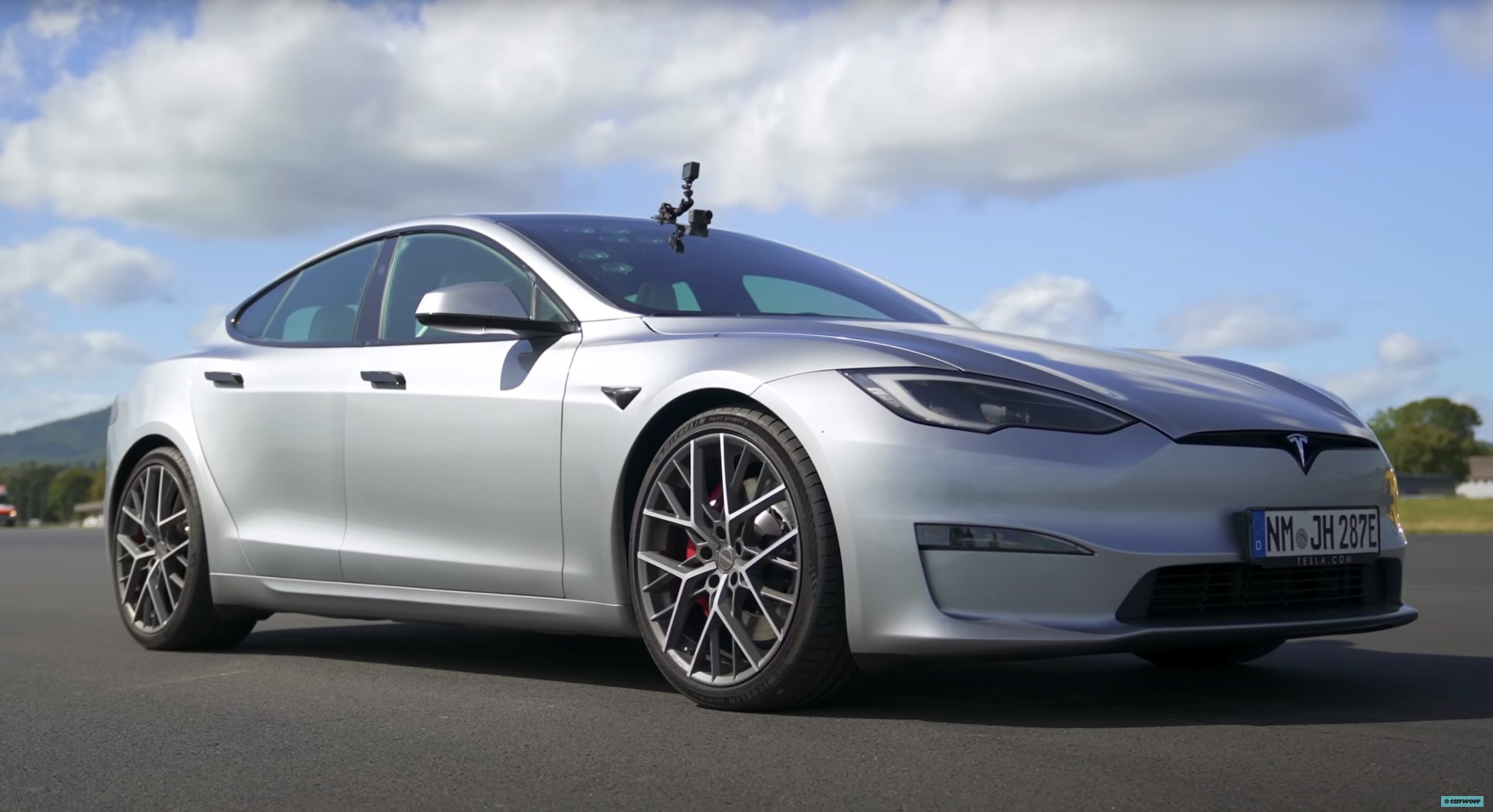
The Tesla Model S Plaid has been around for some time. Today, it is no longer the world’s quickest four-door electric sedan, nor is it the most powerful. As per a recent video from motoring YouTube channel Carwow, however, it seems like the Model S Plaid is still more than a match for some of its newer and more powerful rivals.
The monster from China
The Xiaomi SU7 Ultra is nothing short of a monster. Just like the Model S Plaid, it features three motors. It also has 1,548 hp and 1,770 Nm of torque. It’s All Wheel Drive and weighs a hefty 2,360 kg. The vehicle, which costs just about the equivalent of £55,000, has been recorded setting an insane 7:04.957 at the Nurburgring, surpassing the previous record held by the Porsche Taycan Turbo GT.
For all intents and purposes, the Model S Plaid looked outgunned in Carwow’s test. The Model S Plaid is no slouch with its three motors that produce 1,020 hp and 1,420 Nm of torque. It’s also a bit lighter at 2,190 kg despite its larger size. However, as the Carwow host pointed out, the Model S Plaid holds a 7:25.231 record in the Nurburgring. Compared to the Xiaomi SU7 Ultra’s record, the Model S Plaid’s lap time is notably slower.
Real-world tests
As could be seen in Carwow’s drag races, however, Tesla’s tech wizardry with the Model S Plaid is still hard to beat. The two vehicles competed in nine races, and the older Model S Plaid actually beat its newer, more powerful counterpart from China several times. At one point in the race, the Xiaomi SU7 Ultra hit its power limit due to its battery’s temperature, but the Model S Plaid was still going strong.
The Model S Plaid was first teased five years ago, in September 2020 during Tesla’s Battery Day. Since then, cars like the Lucid Air Sapphire and the Xiaomi SU7 Ultra have been released, surpassing its specs. But just like the Model Y ended up being the better all-rounder compared to the BYD Sealion 7 and the MG IM6, there is just something about Tesla’s tuning and refinement that makes raw specs seem not as game-changing.
Check out Carwow’s Model S Plaid vs Xiaomi SU7 drag race video below.
Lifestyle
500-mile test proves why Tesla Model Y still humiliates rivals in Europe
On paper, the BYD Sealion 7 and MG IM6 promised standout capabilities against the Model Y.
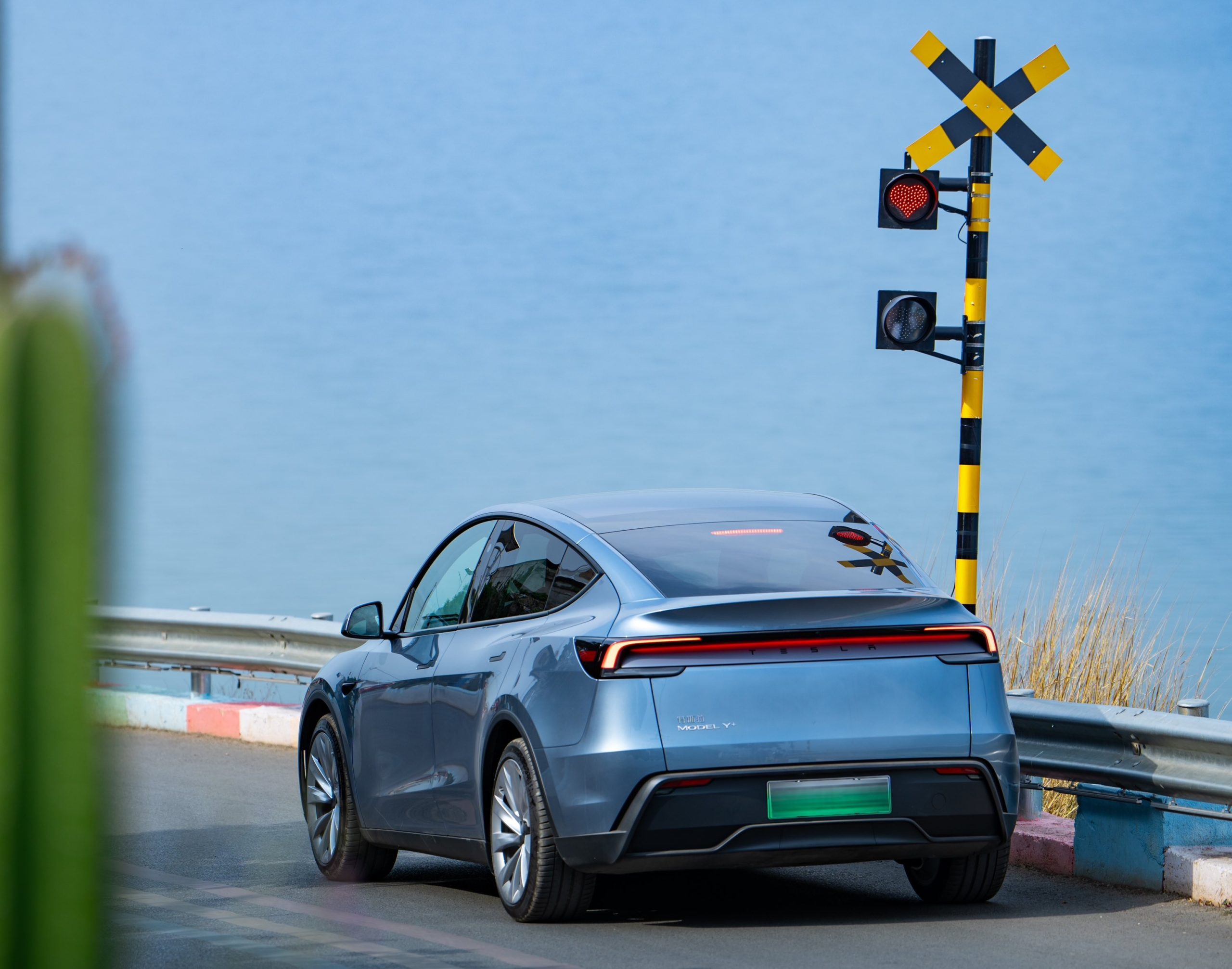
BYD is seeing a lot of momentum in Europe, so much so that mainstream media has taken every opportunity to argue that the Chinese automaker has beaten Tesla in the region. But while BYD sales this year in Europe are rising and Tesla’s registrations remain challenged, the raw capabilities of vehicles like the Model Y are difficult to deny.
This was highlighted in a 500-mile challenge by What Car? magazine, which showed that the new Tesla Model Y is more efficient, cheaper to run, and more reliable than rivals like the BYD Sealion 7, and even the nearly 400 KW-charging MG IM6.
Range and charging promises
On paper, the BYD Sealion 7 and MG IM6 promised standout capabilities against the Model Y. The Sealion 7 had more estimated range and the IM6 promised significantly faster charging. When faced with real-world conditions, however, it was still the Model Y that proved superior.
During the 500-mile test, the BYD nearly failed to reach a charging stop, arriving with less range than its display projected, as noted in a CarUp report. MG fared better, but its charging speeds never reached its promised nearly-400 kW charging speed. Tesla’s Model Y, by comparison, managed energy calculations precisely and arrived at each stop without issue.
Tesla leads in areas that matter
Charging times from 25% to 80% showed that the MG was the fastest at 17 minutes, while Tesla and BYD were close at 28 and 29 minutes, respectively. Overall efficiency and cost told a different story, however. The Model Y consumed 19.4 kWh per 100 km, compared to 22.2 for MG and 23.9 for BYD. Over the full trip, Tesla’s charging costs totaled just £82 thanks to its supercharger network, far below BYD’s £130 and MG’s £119.
What Car? Magazine’s testers concluded that despite BYD’s rapid sales growth and the MG IM6’s seriously impressive charging speeds, Tesla remains the more compelling real-world choice. The Model Y just offers stability, efficiency, and a proven charging infrastructure through its Supercharging network. And as per the magazine’s hosts, the Model Y is even the cheapest car to own among the three that were tested.
Watch What Car? Magazine’s 500-mile test in the video below.
Lifestyle
Tesla Cybertruck slapped with world’s least intimidating ticket, and it’s pure cringe
One cannot help but cringe and feel second-hand embarrassment at the idea of a person just driving around with a stack of these babies.
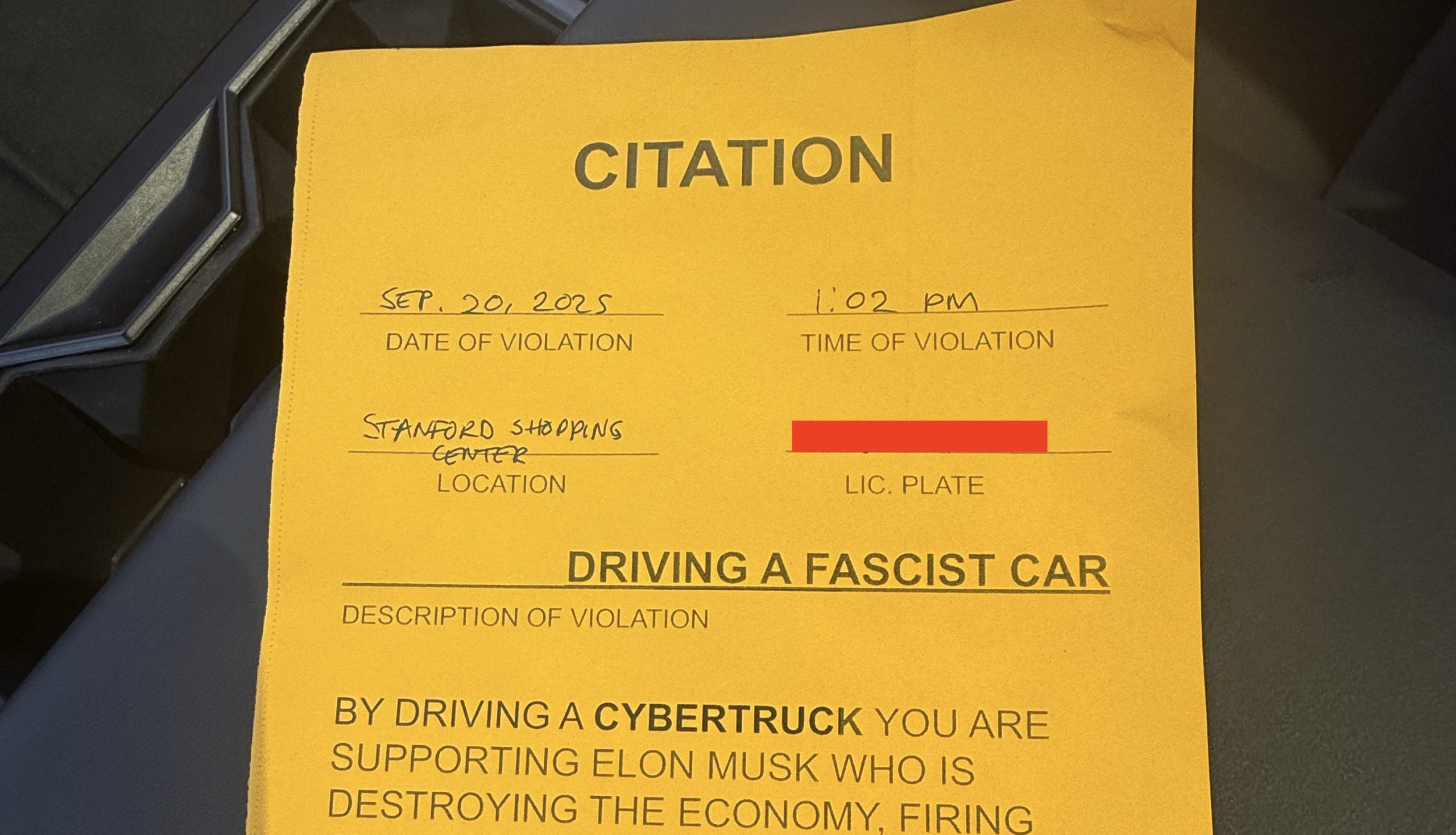
A Cybertruck parked at Stanford Shopping Center in California was recently hit with what might be the most try-hard piece of paper ever slipped under a wiper blade: a “fake citation” accusing the driver of supporting a “fascist car.”
The note, shared on X by Tesla staff program manager Ryan Torres, quickly made the rounds on X, where it quickly gained attention as an example of how not to protest.
The world’s least intimidating ticket
According to the citation, the supposed “violation” was “driving a fascist car.” The remedial action? Take the bus, call an Uber, or ride a bike. The note also dubbed Elon Musk a “chainsaw-wielding Nazi billionaire.” Now, protests against Tesla and Elon Musk have become commonplace this year, but one cannot help but cringe and feel second-hand embarrassment at the idea of a person just driving around with a stack of fake anti-Tesla/Musk citations.
Torres pointed out the irony himself in his post on X. Tesla currently employs over 140,000 Americans, and SpaceX has put the U.S. firmly back at the top of space technology. As Torres put it, maybe the person behind the world’s least intimidating ticket should “read a book on innovation before vandalizing” other people’s property.
Peak performative clownery
Not to mention that the fake ticket’s logic collapses under its own weight. EVs like the Cybertruck are literally designed to reduce emissions, not “destroy the economy.” If anything, Tesla has bolstered the United States’ economy by fueling jobs in engineering, manufacturing, and clean energy. It’s not the first time a Tesla has been the target of vandalism or politically charged notes, but this one stands out for sheer cringe value.
Torres summed it up neatly: “Peak clownery.” On that point, at least, the citation earns full marks. In a way, though, perhaps cringe fake tickets are not as bad as the literal firebombs that were being thrown at Tesla stores and cars earlier this year because some critics were gleefully misinformed about Elon Musk.
